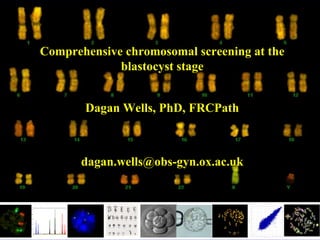
Comprehensive chromosomal screening boosts IVF success rates
- 1. Comprehensive chromosomal screening at the blastocyst stage Dagan Wells, PhD, FRCPath dagan.wells@obs-gyn.ox.ac.uk
- 2. Limitations of conventional embryo screening techniques Cells are in interphase - use FISH Limited range of fluorochromes Less than half the chromosomes tested Spreading requires skill and can be inconsistent Mosaicism Poses a significant problem for diagnosis. However, most mosaic cleavage stage embryos are aneuploid in every cell. Cleavage stage biopsy may represent a cost to the embryo
- 3. Comparative genomic hybridization- CGH • Technique related to FISH • Allows the copy number of every chromosome to be determined Chromosome 15 Test DNA Normal DNA Normal Trisomy Loss Monosomy Gain Normal Kallioniemi et al 1992; Wells et al 1999, 2002; Voullaire et al 1999; Wilton et al 2001; Gutierrez et al 2004, 2005; Fragouli et al 2006, 2007
- 4. Embryo screening using CGH Benefits • All chromosomes tested • DNA-based • No spreading of cells on slides But what about mosaicism and the impact of biopsy?
- 5. Comprehensive chromosome screening of blastocysts Trophectoderm biopsy- 3-10 cells (mean 5) biopsied and tested Courtesy of M. Katz-Jaffe and J. Stevens, CCRM
- 6. Comprehensive chromosome screening of blastocysts Analysis of blastocyst stage • Biopsy of several cells is possible Diagnosis more robust and accurate Less risk of misdiagnosis due to mosaicism Reduced impact of embryo biopsy • Blastocyst cryopreservation (vitrification) necessary • Can overcoming the principal challenges to accurate screening allow PGS to fulfill the potential predicted by theory?
- 7. Blastocyst CGH- clinical results • 170 patients, mean age 38 years, 1-6 previous failed IVF cycles (mean 2) • Near 100% survival after biopsy, freeze and thaw • Pregnancy rate per cycle with transfer 87% 72% • Birth rate per cycle with transfer 79% 60% • Implantation rate per embryo 67% 28% * Control group matched for: maternal age, day-3 FSH, day of transfer, # oocytes retrieved, # of failed cycles *p<0.0003 - Extremely promising for single embryo transfer
- 8. Blastocyst CGH- rates of pregnancy loss • Embryo loss rates are low • 91% of embryos that produced a fetal sac resulted in an ongoing third trimester pregnancy or live birth • 97% of embryos that produced a fetal heart beat resulted in an ongoing third trimester pregnancy or live birth • Expected pregnancy loss rate for IVF patients in this age range is ~25%
- 9. Blastocyst CGH- Pregnancy rates 100 90 80 70 Positive pregnancy 60 per transfer 50 40 Positive pregnancy per cycle with biopsy 30 20 10 0 30-34 35-38 39-42 43-50 Pregnancy rate per transfer shows only a small decline with advancing age Pregnancy rate per cycle shows a significant decline
- 10. Blastocyst CGH- aneuploidy and implantation rates Why does age still lead to reduced pregnancy rates despite aneuploidy screening? 100 90 80 Implantation rate 70 60 Aneuploidy rate 50 40 30 Cycles with all embryos aneuploid 20 10 0 30-34 35-38 39-42 43-50
- 11. Conclusions • Pregnancy rates were above those typically achieved for all age groups. • However, pregnancy rates were lower for older patients due to the increased frequency of cycles with no euploid embryos. • Chromosomally normal embryos from older patients have a similar chance of producing a child as those derived from young patients. • Aneuploidy is likely to be the principal factor causing reduced IVF success with advancing maternal age • Spontaneous abortion rates were reduced for all patients, including those with a history of multiple miscarriage
- 12. Questions • Can the results obtained in the current study be replicated in a randomized controlled trial? • An RCT is currently underway • What patient groups will benefit the most from this type of screening? • Young patients may benefit, particularly in countries where single embryo transfer is mandatory
- 13. United Kingdom (Oxford) Colorado Center for Elpida Fragouli Reproductive Medicine Samer Alfarawati Mandy Katz-Jaffe John Stevens United States (Livingston, NJ) Bill Schoolcraft Pere Colls Tomas Escudero N-neka Esprit-Ngachou Jill Fischer Cristina Gutierrez-Mateo Santiago Munne Renata Prates Jorge Sanchez Sophia Tormasi John Zheng Dagan.Wells@obs-gyn.ox.ac.uk